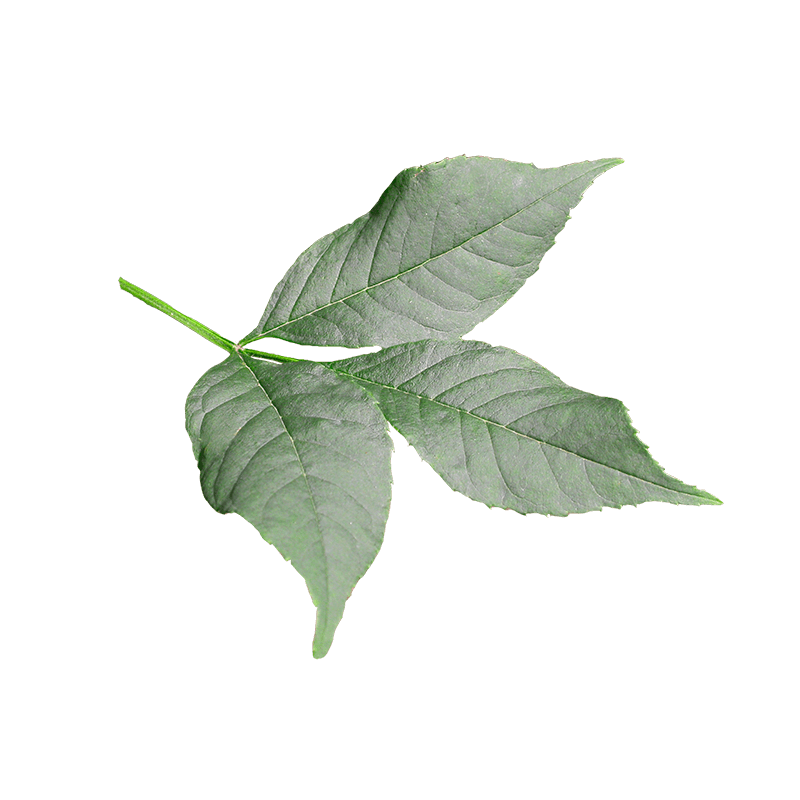
Ash
Latin name
Origin
Used part
Active components
Flavonoids (quercetin): antioxidant and anti-inflammatory action.
Coumarin (fraxin, fraxetin): antioxidant and anti-inflammatory action.
Secoiridoids: anti-inflammatory action through anticomplement action
Usage
Ash is used in the culinary world. The young seeds are soaked in salt and vinegar and are then used as condiments. Ash leaves are sometimes added to tea or other types of infusions to adjust the flavour or to add their effect. An edible oil, similar to sunflower oil is obtained from the seeds. There is also a carbonated drink made using ash leaves: ash cider or frênette. The leaves, which are covered in a sweet substance, are decocted and then fermented. This sweet substance comes from an ash exudate resulting from the activity of an aphid. This drink, ash cider or frênette, is best known in northern France. Traditional medicine notes the use of leaves for their diuretic, sudorific and laxative effect. The plant has particularly been used in the treatment of gout and rheumatism. Recently, studies have demonstrated a stimulant effect on the kidneys resulting in the increased elimination of water and toxins.1 Ash also contributes to the flexibility of joints, muscles and tendons. It helps to alleviate joint pain.2-20
Bibliographical references
- Herbal medicines as diuretics: a review of the scientific evidence.
Wright CI, Van-Buren L, Kroner CI, Koning MM.
J Ethnopharmacol. 2007 Oct 8;114(1):1-31.
Pubmed: http://www.ncbi.nlm.nih.gov/pubmed/17804183 - Biochemical model reactions indicative of inflammatory processes. Activities of extracts from Fraxinus excelsior and Populus tremula.
Schempp H, Weiser D, Elstner EF.
Arzneimittelforschung. 2000 Apr;50(4):362-72.
Pubmed: http://www.ncbi.nlm.nih.gov/pubmed/10800635 - Pharmacological and clinical effectiveness of a fixed phytogenic combination trembling poplar (Populus tremula), true goldenrod (Solidago virgaurea) and ash (Fraxinus excelsior) in mild to moderate rheumatic complaints.
Klein-Galczinsky C.
Wien Med Wochenschr. 1999;149(8-10):248-53.
Pubmed: http://www.ncbi.nlm.nih.gov/pubmed/10483692 - Effects of extracts from Populus tremula L., solidago virgaurea L. and Fraxinus excelsior L. on various myeloperoxidase systems.
von Kruedener S, Schneider W, Elstner EF.
Arzneimittelforschung. 1996 Aug;46(8):809-14.
Pubmed: http://www.ncbi.nlm.nih.gov/pubmed/9125284 - Superoxide-dependent and -independent nitrite formation from hydroxylamine: inhibition by plant extracts.
Rohnert U, Schneider W, Elstner EF.
Z Naturforsch C. 1998 Mar-Apr;53(3-4):241-9.
Pubmed: http://www.ncbi.nlm.nih.gov/pubmed/9687163 - A combination of Populus tremula, Solidago virgaurea and Fraxinus excelsior as an anti-inflammatory and antirheumatic drug. A short review.
von Kruedener S, Schneider W, Elstner EF.
Arzneimittelforschung. 1995 Feb;45(2):169-71.
Pubmed: http://www.ncbi.nlm.nih.gov/pubmed/7710441 - Anti-inflammatory, analgesic and antipyretic effect of various plant extracts and their combinations in an animal model.
Okpanyi SN, Schirpke-von Paczensky R, Dickson D.
Arzneimittelforschung. 1989 Jun;39(6):698-703.
Pubmed: http://www.ncbi.nlm.nih.gov/pubmed/2476136 - Fraxetin inhibits the induction of anti-Fas IgM, tumor necrosis factor-alpha and interleukin-1beta-mediated apoptosis by Fas pathway inhibition in human osteoblastic cell line MG-63.
Kuo PL, Huang YT, Chang CH, Chang JK.
Int Immunopharmacol. 2006 Jul;6(7):1167-75.
Pubmed: http://www.ncbi.nlm.nih.gov/pubmed/16714221 - Natural and synthetic coumarin derivatives with anti-inflammatory/ antioxidant activities.
Fylaktakidou KC, Hadjipavlou-Litina DJ, Litinas KE, Nicolaides DN.
Curr Pharm Des. 2004;10(30):3813-33.
Pubmed: http://www.ncbi.nlm.nih.gov/pubmed/15579073 - Pharmacological and biochemical actions of simple coumarins: natural products with therapeutic potential.
Hoult JR, Payá M.
Gen Pharmacol. 1996 Jun;27(4):713-22.
Pubmed: http://www.ncbi.nlm.nih.gov/pubmed/8853310 - Inhibition of the formation of 5-hydroxy-6,8,11,14-eicosatetraenoic acid from arachidonic acid in polymorphonuclear leukocytes by various coumarins.
Kimura Y, Okuda H, Arichi S, Baba K, Kozawa M.
Biochim Biophys Acta. 1985 Apr 25;834(2):224-9.
Pubmed: http://www.ncbi.nlm.nih.gov/pubmed/3922420 - Dual anti-oxidative effects of fraxetin isolated from Fraxinus rhinchophylla.
Thuong PT, Pokharel YR, Lee MY, Kim SK, Bae K, Su ND, Oh WK, Kang KW.
Biol Pharm Bull. 2009 Sep;32(9):1527-32.
http://www.ncbi.nlm.nih.gov/pubmed/19721227 - Antioxidant, Antibacterial Activities and General Toxicity of Alnus glutinosa, Fraxinus excelsior and Papaver rhoeas.
P Middleton; F Stewart; S Al-Qahtani; P Egan; C O’Rourke; A Abdulrahman; M Byres; M Middleton; Y Kumarasamy; M Shoeb; L Nahar; A Delazar; SD Sarker
Iranian Journal of Pharmaceutical Research (2005) 2: 81-86
Iranian Journal of Pharmaceutical Research: http://ijpr.sbmu.ac.ir/?_action=articleInfo&article=620
14. Antioxidative properties of alcoholic extracts from Fraxinus excelsior, Populus tremula and Solidago virgaurea.
Meyer B, Schneider W, Elstner EF.
Arzneimittelforschung. 1995 Feb;45(2):174-6.
Pubmed: http://www.ncbi.nlm.nih.gov/pubmed/7710443 - Complement-Mediated Antiinflammatory Action of Extracts and Pure Secoiridoids Isolated from Fraxinus Species
Nina Ivanovska, Tanya Iossifova, Ivanka Kostova
Phytotherapy Research Volume 10, Issue 7, pages 555–558, November 1996
Wiley Online Library: http://onlinelibrary.wiley.com/doi/10.1002/(SICI)1099-1573(199611)10:7%3C555::AID-PTR908%3E3.0.CO;2-S/abstract - Natural compounds,fraxin and chemicals structurally related to fraxin protect cells from oxidative stress.
Whang WK, Park HS, Ham I, Oh M, Namkoong H, Kim HK, Hwang DW, Hur SY, Kim TE, Park YG, Kim JR, Kim JW.
Exp Mol Med. 2005 Oct 31;37(5):436-46.
Exprimental & Molecular Medecine: http://www.nature.com/emm/journal/v37/n5/abs/emm200554a.html - Antioxidant activity of Fraxetin: in vivo and ex vivo parameters in normal situation versus induced stress.
Fernandez-Puntero B, Barroso I, Iglesias I, Benedí J, Villar A.
Biol Pharm Bull. 2001 Jul;24(7):777-84.
Pubmed: http://www.ncbi.nlm.nih.gov/pubmed/11456117 - Effects of fraxetin on glutathione redox status.
Martín-Aragón S, Benedí JM, Villar AM.
Z Naturforsch C. 1997 Jan-Feb;52(1-2):55-9.
Pubmed: http://www.ncbi.nlm.nih.gov/pubmed/9162171 - Superoxide anion scavenging effect of coumarins.
Chang WS, Lin CC, Chuang SC, Chiang HC.
Am J Chin Med. 1996;24(1):11-7.
Pubmed: http://www.ncbi.nlm.nih.gov/pubmed/8739177 - Superoxide scavenging activity in leukocytes and absence of cellular toxicity of a series of coumarins.
Paya M, Goodwin PA, De Las Heras B, Hoult JR.
Biochem Pharmacol. 1994 Aug 3;48(3):445-51.
Pubmed: http://www.ncbi.nlm.nih.gov/pubmed/8068031
The health claims that feature on our website in relation to the plants contained in our products are compliant with the list of health claims awaiting final assessment by the Community authorities (cf. website of the European Commission: http://ec.europa.eu/nuhclaims/). However, they may be subject to modification following their assessment by the national competent authorities.
The health claims relating to other nutrients or substances contained in our products that feature on our site are compliant with Regulation No. 432/2012 of the Commission of 16 May 2012 which establishes a list of authorised health claims authorised in relation to food products, other than those in reference to the reduction of the risk of disease as well as community-based development and child health (cf. website of the European Commission: http://ec.europa.eu/nuhclaims/).

 Belgique
Belgique  België
België  France
France  Italia
Italia  Portugal
Portugal  España
España  United Kingdom
United Kingdom  Κύπρος
Κύπρος 